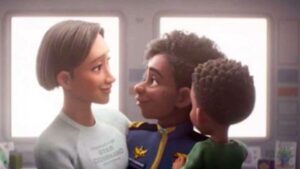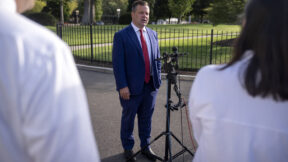The New Lightyear Movie Tears Down 250 Years of Traditional Western Values

Photo: Disney/Pixar
This weekend, your friendly neighborhood Mediaite contributing editor watched Pixar’s latest cinematic offering, Lightyear, and was shocked, shocked, I tell you, by some truly offensive content in the film, far more disturbing and with the potential to cause more actual harm to American homes than any of the tweeted scaremongering about this movie could have possibly prepared you to face.
[SPOILER ALERT: This article contains a series of minor to increasingly major spoilers about Lightyear, including key plot reveals, character developments, and other information not revealed in the trailers. If you haven’t seen the film yet, consider yourself warned.]
Lightyear tells the origin story of Buzz Lightyear, the swaggerific spaceman toy whose battle with retro cowboy Woody for the devotion of a boy named Andy was the heart of Pixar’s first-ever feature film, 1995’s Toy Story.
The movie sets up this backstory at the very beginning with a title card explaining how in 1995 “a boy named Andy got a toy from his favorite movie. This is that movie.”
The “real” Buzz Lightyear (voiced by Captain America himself, Chris Evans) is on a mission with his Space Rangers partner and best friend, Alisha Hawthorne (voiced by Orange is the New Black’s Uzo Aduba), piloting a gigantic spacecraft exploring a hostile alien planet while hundreds of passengers are in suspended animation. As they attempt to escape the planet, Buzz rejects an offer of help from a rookie Space Ranger and ends up badly damaging the ship, crash landing, and stranding everyone (as seen starting at the 20-second mark in the trailer below).
Feeling guilty, Buzz becomes obsessively focused on developing a new fuel that will be able to reach “hyperspeed,” the faster-than-light theoretical method of travel, and allow everyone to return home. As Alisha and the rest of the crew busy themselves constructing a settlement on the new planet, Buzz experiments with his space jet.
Fans of Albert Einstein’s theory of special relativity or any of the multitude of science fiction works containing this trope will likely predict the problem that arises: every attempted test flight where Buzz approaches light speed will last only minutes for him, but years will go by on the planet below.
Four years pass during his first jaunt, with the time dilation increasing as he gets closer to a stable hyperdrive, eventually leaving Buzz two generations into the future to team up with Alisha’s granddaughter Izzy Hawthorne (voiced by Keke Palmer), who dreams of being a Space Ranger like her grandma.
Buzz and Izzy are joined on their escapades by two other wannabe Space Rangers (the adorkable Mo Morrison, voiced by Taiki Waititi, and Darby Steel, a convict-with-a-heart-of-gold whose gravely voice is provided by another Orange is the New Black alumna, Dale Soules) plus a ridiculously cute robotic cat named Sox (voiced by Peter Sohn).

Photo: Disney/Pixar
The scandalous scene that should horrify all decent members of society occurs when this ragtag crew stops for a snack break and retrieves boxed sandwiches from a vending machine. Buzz is bewildered when he opens the package to find that the meat and other sandwich contents are on both sides of a single slice of bread.
His new friends laugh at Buzz’s confusion, insisting that a “bread-meat-bread” configuration is too bread-heavy and extolling the joy of “juicy fingers” that result from eating the “meat-bread-meat” type.
This is a horrific outrage, as anyone with the tiniest shred of basic human decency must admit.
Those who accuse Disney of disrespecting traditional values can point to this scene, which thumbs its nose at John Montagu, 4th Earl of Sandwich, the 18th-century British statesman whose name inspired the dearly beloved staple of lunchboxes and cafés around the world.
Real American patriots know that a “meat-bread-meat” sandwich not only shows contempt for the more than 250 years of Lord Sandwich’s distinguished legacy but also disregards the entire raison d’être for the sandwich’s existence: to allow you to eat meat without needing silverware or napkins, or pausing to wash your hands before resuming activities.
As legend goes, Lord Sandwich, a notorious womanizer and prolific gambler, was loath to leave the card table for meals. He ordered his servants to bring him meat between two slices of bread to avoid making a mess, or, perhaps the worse sin for a gambler: inadvertently marking the cards. He was truly an inspiration to us all. (One might say an adulterous rake with gambling issues is a questionable role model, but many of the same “party of family values” people criticizing Lightyear want to re-elect thrice-married failed casino magnate Donald Trump as president, so just roll with it.)
With full cognizance of how much children adore mimicking their characters, Disney expects parents who have endured endless renditions of Frozen’s “Let It Go” and ill-informed pleas to adopt Dalmatian puppies to now battle their offsprings’ wishes to possess stickier fingers than ever before. It’s only a matter of time before some kindergartener who just wants to watch the world burn demands Mom make a peanut butter and jelly sandwich assembled in this inside-out bizarro way. The only thing that might be worse would be a Lightyear sequel in which robocat Sox spits bursts of glitter, which I’ve heard more than one mother of small children bitterly refer to as the “herpes of craft supplies.” Quelle horreur!
Even during the most furious of debates in the Twitterverse over whether a hot dog is a sandwich, no one is proposing putting the frankfurter anywhere other than inside the bun. In 2006, a Massachusetts court ruled that “burritos, quesadillas, and tacos are not commonly understood to mean ‘sandwiches,'” but still, the litigants respected the pillars of Western civilization and kept the toppings demurely contained within the tortillas. Families are already struggling with inflation and supply chain woes and there isn’t nearly enough Lysol or Fabuloso on grocery store shelves to cope with the looming exponential increase in tiny fingerprints soon to deface America’s refrigerators, kitchen cabinets, and upholstered furniture.
I’m obviously being highly sarcastic about all this sandwich deviancy, but two other Lightyear controversies have been percolating in the right-wing mediasphere: one regarding the casting of Evans over Tim Allen, who voiced Buzz in the original Toy Story films, and the second regarding That Scandalous Lesbian Kiss.
Casting Evans has been unfairly portrayed as a snub of Allen, supposedly for his conservative political leanings. However, The House The Mouse Built continues to shovel massive piles of cash Allen’s way, hiring him to voice the toy version of Buzz in a growing list of Toy Story television programs, video games, and cameo appearances in other Disney works. Allen, joined by several of his fellow executive producers from Last Man Standing, is also set to reprise his role from the Santa Clause films in The Clauses, a miniseries to air this fall on Disney+. It’s literally the exact opposite of being blacklisted.
Besides the real-life issue that human voices change as we age — Allen is now 69 years old and it makes more sense to have Millennial Evans voice the strapping young Space Ranger than a guy who qualifies for Medicare — the Lightyear creative team was open about their desire to take a different route for their portrayal of Buzz the Human vs. Buzz the Toy.
Director Angus MacLane told Vanity Fair that while Allen’s Buzz was meant to be “comic relief,” the Lightyear character is more of a traditional “action hero,” intended to be “serious and ambitious and funny, but not in a goofy way that would undercut the drama.” Evans’ star-making tenure as Captain America showed the actor had the “gravitas” and “movie-star quality” that MacLane sought to distinguish Lightyear’s Buzz from the toy figurine in Toy Story. That same article includes Evans’ effusive praise for his predecessor, saying he used Allen’s Buzz as a “guideline” but worked hard to avoid a “shameless impression,” seeking to “create my own understanding of the character…while paying homage to the great work that he did.”
Now, the way many conservative commentators have reacted to That Scandalous Lesbian Kiss, you might think Lightyear contained the vilest sort of graphic sex scenes. Sen. Ted Cruz (R-TX) in particular has been fired up about the menace of Disney’s alleged plot to corrupt the youth of America, breathlessly accusing the company of being on the brink of airing animated bacchanalias between Mickey and Pluto.
The actual reality of That Scandalous Lesbian Kiss is it’s an extremely chaste closed-mouth peck, lasting a mere fraction of a second and between two characters who are in a stable and loving marriage. The first season scene in Netflix’s Bridgerton where Daphne and Simon hold hands while looking at a painting is far more sensual than this fleeting kiss.
The full background of the characters involved in That Scandalous Lesbian Kiss further highlights how exaggerated the outrage truly is. Upon Buzz’s initial return from his four-year time-displacing travel, Alisha excitedly tells him she’s engaged and he happily congratulates her. She shares with her friend how she met her fiancée, science officer Kiko, three years ago.
A montage shows time flying by as Buzz checks in on his friend when he returns every few years, portraying Alisha and Kiko married, Alisha pregnant, and the couple raising a son. Their son graduates from college, gets married, and has daughter Izzy. Eventually Buzz’s travels outlast Alisha’s lifespan, and he returns to find a poignant video message she left for him, clearly content with her fulfilling life with her family.

Photo: Disney/Pixar
In other words, That Scandalous Lesbian Kiss is between two educated women with professional jobs who know each other for several years before getting married, have a child only after they’re married, stay married for life, and raise a son who also appears to get married before having his daughter and stays married to the child’s mother.
This concept of marrying for life and being married before having children is — dare I say it? — a very conservative principle. Perhaps That Scandalous Lesbian Kiss is not so scandalous after all.
More importantly, the underlying message of the movie is that love and family are far more important than any celebrity status.
At the end of the movie, Buzz has the chance to travel back in time and undo their visit to the alien planet. That would mean that no one would know about his embarrassing crash landing and his bestie Alisha would rejoin him as a Space Ranger. But it would also mean that Alisha’s happy home life and two generations of her family would be erased; she would have never met Kiko if they hadn’t been stranded on that planet together.
Buzz won’t steal that joy from Alisha, and he doesn’t want to erase his new friend Izzy’s existence either. You could even call it a pro-life and pro-family message, that Buzz refuses to prevent Izzy from being born, even though that would facilitate more exciting Space Ranger adventures for him and Alisha.
Over and over, Lightyear promotes the message that honesty and loyalty matter, it’s brave to face your fears and try to correct your mistakes, and the mundane everyday moments with the people you love are more valuable than any fame or fortune — which, when you really think of it, is perhaps the most shocking message of all from a $200 million major studio film starring famous actors and poised to launch Disney’s merchandising revenues to infinity and beyond with that lil’ robot Sox.
To test this theory, I called a friend of mine to interview her and her six-year-old son, both of whom just watched the movie. I asked the boy what was his favorite part about Lightyear, which he has enthusiastically declared as his new “favorite ever!” Pixar film.
“Probably Sox,” he replied, happily chattering away about how it was “cool” how Sox helped his friend Buzz solve puzzles and “literally is a weapon!” referring to a humorous bit in which Sox launches tranquilizer darts at a foe to enable Buzz to escape. He was also very fascinated with all the robots.
Nothing, and I mean not one single detail, about That Not Actually Scandalous Lesbian Kiss even made it onto this six-year-old’s radar. He knew Izzy was Alisha’s granddaughter but didn’t pay attention to the background family characters who have some grownups so riled up. There were, after all, lots of cool robots with lasers and a really big spaceship.
“No kid, in any way, is noticing any of this,” my friend confirmed with a laugh. Having actually seen the movie, it’s illogical to argue Lightyear is going to indoctrinate kids into anything, other than asking for Sox toys for their next birthday. Disney isn’t grooming kids into homosexuality; they’re grooming them to buy merch.
With absolutely zero sexual content in this film, the conservative fury over That Not Actually Scandalous Lesbian Kiss is not just more exaggerated culture war fauxtrage, it’s an admission that they find the mere existence of a lesbian couple to be offensive.
Every parent has the right to decide what movies are or are not appropriate for their children to watch. But let’s be honest about what Lightyear actually represents, what we actually find objectionable, and let parents make informed decisions based on the real content of the film, not garbage from campaign fundraising emails and scaremongering tweets.
This is an opinion piece. The views expressed in this article are those of just the author.




